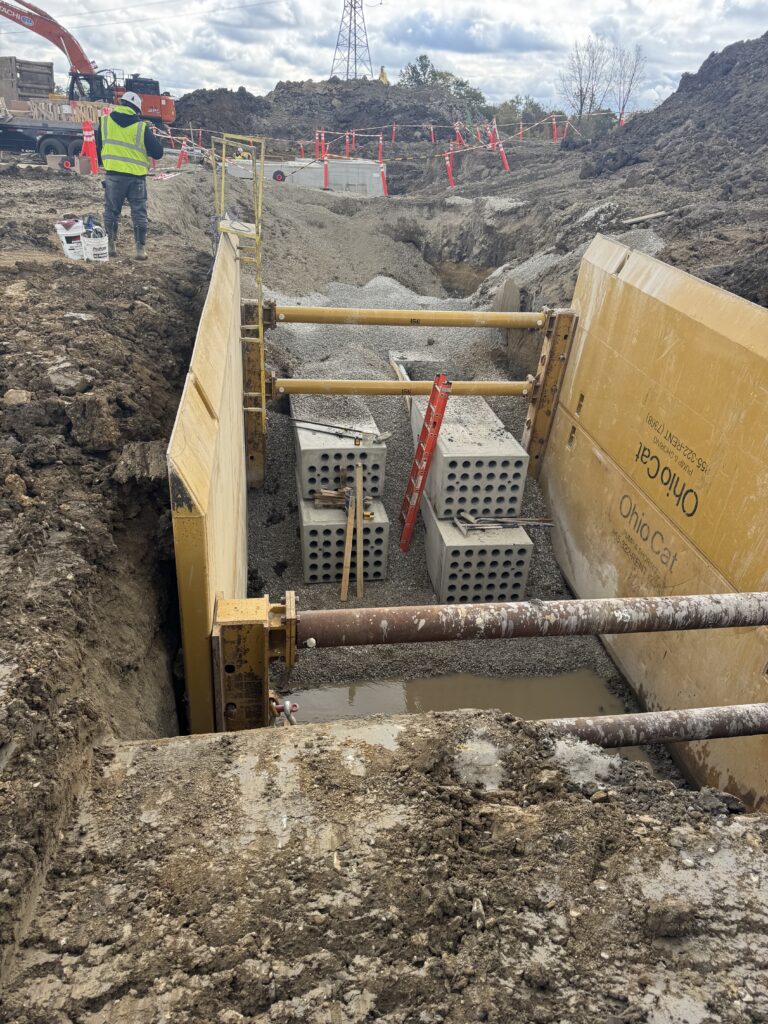Every truck that doesn’t leave a batch plant cuts fuel, time, and carbon. Traditional cast-in-place duct banks require a constant flow of ready-mix trucks, aggregate hauls, and job-site deliveries. Each trip adds diesel emissions and traffic exposure that don’t appear anywhere on the bid sheet.
DBO’s vertically integrated supply chain shortens that path from quarry to trench — reducing both carbon and complexity.
Vertical Integration = Lower Emissions Per Yard
DBO operates with full control over material sourcing and batching. Rather than depending on multiple outside suppliers, we coordinate directly between our aggregate source, cement terminal, and precast facility.
The network includes:
- A cement terminal linked to regional producers.
- A quarry and aggregate yard adjacent to our plant.
- Rail connections for long-haul inbound materials.
According to the Association of American Railroads, moving freight by rail produces up to 75 percent fewer greenhouse-gas emissions per ton-mile than highway trucking . By shifting bulk material shipments to rail and eliminating redundant ready-mix trips, DBO materially lowers the transportation footprint of every cubic yard poured in our facility.
Fewer Trips, Smarter Loads
A single DBO flatbed can deliver multiple finished duct-bank sections in one trip. A comparable cast-in-place run would require several ready-mix truckloads, support vehicles, and a return haul for each pour.
The National Ready Mixed Concrete Association reports that average ready-mix deliveries travel 25 miles one way. Replacing six to eight of those trips with a single precast delivery eliminates more than 150 truck-miles of diesel travel per 100 linear feet of duct bank — a direct reduction in fuel burn and CO₂ output.
Controlled Production = Lower Embodied Carbon
Once materials reach the plant, DBO’s controlled batching and curing process minimizes waste and over-pour. NRMCA’s industry-average Environmental Product Declaration shows that optimized high-strength mixes can reduce embodied CO₂ by 15–25 percent compared with conventional job-site concrete . DBO’s mix designs fall within that optimized range, achieving equivalent strength with less cement content and virtually no waste concrete.
Less Hauling, Less Idling, Safer Sites
Reducing truck traffic doesn’t just cut emissions — it also cuts congestion and on-site hazards.
- Fewer deliveries mean fewer heavy-equipment interactions near open trenches.
- Less idling equipment lowers particulate exposure for crews.
- Consolidated material logistics simplify scheduling and staging.
Each of those gains supports the same sustainability metrics large-scale owners now track: embodied-carbon intensity, fuel consumption, and worker-safety exposure per megawatt or square foot built.
Why It Matters to Large-Scale Developers
Major data-center and industrial owners evaluate embodied-carbon performance the same way they measure uptime or PUE. DBO’s documentation makes that data easy to report:
- Batch-level traceability for aggregates and cement.
- Transportation records showing rail versus truck mileage.
- Environmental Product Declarations aligned with NRMCA methodology.
That transparency helps contractors meet their clients’ Scope 3 targets without adding administrative burden.
Built Cleaner from the Start
Every DBO duct bank starts with materials that travel less, use less, and waste less. By combining vertical integration with rail logistics, we’ve engineered sustainability into the supply chain itself — not as an add-on, but as the way we build. That’s how modern underground infrastructure reduces its carbon footprint: shorter routes, smarter moves, verified results.



